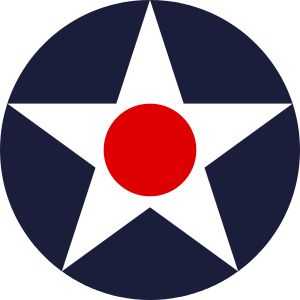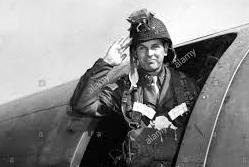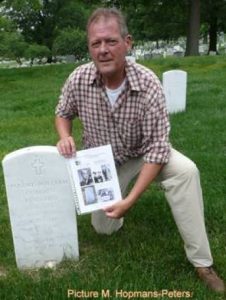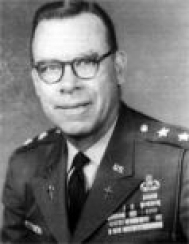 His father a shipbuilder in that state, was Joseph E Johnson, and was 33 and his mother, Bertha, born Lovenstein, was 32 when Howard was born. Howard married Mary Evelyn Brothers on 25-01-1929, in Salt Lake City, Salt Lake, Utah. Graduating from Central High School in Washington, D.C., Johnson attended the U.S. Naval Academy in Annapolis
His father a shipbuilder in that state, was Joseph E Johnson, and was 33 and his mother, Bertha, born Lovenstein, was 32 when Howard was born. Howard married Mary Evelyn Brothers on 25-01-1929, in Salt Lake City, Salt Lake, Utah. Graduating from Central High School in Washington, D.C., Johnson attended the U.S. Naval Academy in Annapolis  . Before he was scheduled to graduate, Johnson went to Texas, where he tried to become a pilot in the Army Air Corps.
. Before he was scheduled to graduate, Johnson went to Texas, where he tried to become a pilot in the Army Air Corps.  The instructors sent him away because of poor “side vision.” Johnson stayed in the Army, however, and was stationed in the Panama Canal Zone, Fort Sill, Oklahoma, and in China, before returning to his home state of Maryland, where he would be posted at Fort Meade. Before World War II broke out, Johnson, by then advancing in rank, was driving a jeep when it flipped over, severely injuring him. After he eventually recovered, his commanders offered him the chance to command the First Special Service Force
The instructors sent him away because of poor “side vision.” Johnson stayed in the Army, however, and was stationed in the Panama Canal Zone, Fort Sill, Oklahoma, and in China, before returning to his home state of Maryland, where he would be posted at Fort Meade. Before World War II broke out, Johnson, by then advancing in rank, was driving a jeep when it flipped over, severely injuring him. After he eventually recovered, his commanders offered him the chance to command the First Special Service Force  Colonel Johnson didn’t think that it would ever be an effective fighting force. The Black Devils went on to fight in World War II, earning recognition for its nighttime raids behind the German lines at Anzio Beach.
Colonel Johnson didn’t think that it would ever be an effective fighting force. The Black Devils went on to fight in World War II, earning recognition for its nighttime raids behind the German lines at Anzio Beach.  Soon, his superiors gave him the opportunity to command another combat unit. It was called the 501st Parachute Infantry Regiment. The colonel accepted. After the regiment endured rigorous training at Camp Toccoa
Soon, his superiors gave him the opportunity to command another combat unit. It was called the 501st Parachute Infantry Regiment. The colonel accepted. After the regiment endured rigorous training at Camp Toccoa  and Fort Benning, Georgia, it was sent to North Carolina for military maneuvers. In January 1944, Colonel Johnson and the 501 st Parachute Infantry
and Fort Benning, Georgia, it was sent to North Carolina for military maneuvers. In January 1944, Colonel Johnson and the 501 st Parachute Infantry  sailed to England. By now, “Jumpy” Johnson had installed a positive attitude in them which led to a fighting spirit. The morale of the 501st stayed rather high the entire time Colonel Howard Johnson was with them and after he was gone. On D-Day, the 501st, now permanently attached to the 101st Airborne Division
sailed to England. By now, “Jumpy” Johnson had installed a positive attitude in them which led to a fighting spirit. The morale of the 501st stayed rather high the entire time Colonel Howard Johnson was with them and after he was gone. On D-Day, the 501st, now permanently attached to the 101st Airborne Division  , Commander of the 101st Airborne Division, Maxwell Davenport Taylor
, Commander of the 101st Airborne Division, Maxwell Davenport Taylor 

 assigned to seize some canal locks and demolish the bridges over the Douve River. One battalion would be in the 101st Division reserve. When the men of the ‘Geronimo Regiment’ parachuted into Normandy, they were widely scattered. Johnson gathered a group of his men and as platoons and companies in the regiment got back together, they annihilated a battalion of German paratroopers guarding the canal locks. The 501st Regiment, led by Colonel Johnson, had a successful mission, even though in a way that General Dwight Eisenhower’s
assigned to seize some canal locks and demolish the bridges over the Douve River. One battalion would be in the 101st Division reserve. When the men of the ‘Geronimo Regiment’ parachuted into Normandy, they were widely scattered. Johnson gathered a group of his men and as platoons and companies in the regiment got back together, they annihilated a battalion of German paratroopers guarding the canal locks. The 501st Regiment, led by Colonel Johnson, had a successful mission, even though in a way that General Dwight Eisenhower’s  planners never imagined. The 101st Division became the First Army reserve in July 1944, so after a month of fighting, the 501st Regiment was able to rest. The 101st Airborne, including Colonel Johnson and his men, Colonel Harry Kinnard,
planners never imagined. The 101st Division became the First Army reserve in July 1944, so after a month of fighting, the 501st Regiment was able to rest. The 101st Airborne, including Colonel Johnson and his men, Colonel Harry Kinnard,


 airborne priest Father Francis Leon Sampson,
airborne priest Father Francis Leon Sampson,


 and Richard “Dick” Winters
and Richard “Dick” Winters  Dick Winters was ordered to seize 15 miles of highway, including several bridges, in Holland as part of the combined airborne/armored Operation Market Garden (see About).
Dick Winters was ordered to seize 15 miles of highway, including several bridges, in Holland as part of the combined airborne/armored Operation Market Garden (see About).  The 501st PIR landed and organized itself. Always among his men, Johnson provided an example of leadership in the battlefield as he led his men to seize their objectives and get into good positions once a British armored corps linked up with them. Although part of Operation Market Garden
The 501st PIR landed and organized itself. Always among his men, Johnson provided an example of leadership in the battlefield as he led his men to seize their objectives and get into good positions once a British armored corps linked up with them. Although part of Operation Market Garden 
 failed, the 501st, led by “Jumpy” Johnson, had seized its objectives. When the 101st Airborne Division dug in on the “Island”, a small strip of land between the Waal and Rhine Rivers, the 501st was subjected to mortar and artillery fire that killed and maimed many men. Colonel Johnson was able to keep the morale up and the regiment executed several successful patrols.
failed, the 501st, led by “Jumpy” Johnson, had seized its objectives. When the 101st Airborne Division dug in on the “Island”, a small strip of land between the Waal and Rhine Rivers, the 501st was subjected to mortar and artillery fire that killed and maimed many men. Colonel Johnson was able to keep the morale up and the regiment executed several successful patrols.
Death and burial ground of Johnson, Howard Ravenscroft “Jumpy’.



 On 08-10-1944, Johnson and his young executive officer, Lieutenant Colonel Julian Ewell he died old age 93, on 27-07-2009, in Fairfax
On 08-10-1944, Johnson and his young executive officer, Lieutenant Colonel Julian Ewell he died old age 93, on 27-07-2009, in Fairfax
 on a West Point graduate, were visiting the front lines. Suddenly, some mortar shells hit the area. Men raced for cover and got down. Some of them were killed by the barrage. A large fragment hit the Colonel in the stomach. He fell to the ground. The medics knew that the wound was very serious, if not fatal. Two hours later, Johnson groaned, “Take care of my boys” to Colonel Ewell, who would take the command of the regiment. Seconds later, he was dead. The 101st Airborne Division had the next losses during their campaign in Europe; In Normandy, killed/died of wounds 868, wounded in action 2.303, missing/captured 665. In Holland killed 752, wounded 2.151 and missing 398. In the battle of the Bulge in Belgium, killed 482, wounded 2.449 and missing 527, in total killed 2.043, wounded 2.782 and missed 1590. Colonel Howard Ravenscroft Johnson is buried on Arlington Cemetery, Section 11. Also buried in Section 11, Major General, Commander 106th Infantry Division
on a West Point graduate, were visiting the front lines. Suddenly, some mortar shells hit the area. Men raced for cover and got down. Some of them were killed by the barrage. A large fragment hit the Colonel in the stomach. He fell to the ground. The medics knew that the wound was very serious, if not fatal. Two hours later, Johnson groaned, “Take care of my boys” to Colonel Ewell, who would take the command of the regiment. Seconds later, he was dead. The 101st Airborne Division had the next losses during their campaign in Europe; In Normandy, killed/died of wounds 868, wounded in action 2.303, missing/captured 665. In Holland killed 752, wounded 2.151 and missing 398. In the battle of the Bulge in Belgium, killed 482, wounded 2.449 and missing 527, in total killed 2.043, wounded 2.782 and missed 1590. Colonel Howard Ravenscroft Johnson is buried on Arlington Cemetery, Section 11. Also buried in Section 11, Major General, Commander 106th Infantry Division  , Ardennes Offensive.Alan Walter Jones,
, Ardennes Offensive.Alan Walter Jones,  the Lieutenant General, Commanding General, Normandy, Henry Aurand,
the Lieutenant General, Commanding General, Normandy, Henry Aurand,  Air Force Brigadier General, Chief of Staff Second Air Force, Nathan Forrest III, General Lieutenant, Commander of the 10th Mountain Division, Georg Hays, Lieutenant Colonel and Fighter ace, “The Boise Bee”,
Air Force Brigadier General, Chief of Staff Second Air Force, Nathan Forrest III, General Lieutenant, Commander of the 10th Mountain Division, Georg Hays, Lieutenant Colonel and Fighter ace, “The Boise Bee”, Duane Beeson, the Flyer Ace, Marine Corps Brigade General, Carlson’s Raiders, “Gung Ho”,
Duane Beeson, the Flyer Ace, Marine Corps Brigade General, Carlson’s Raiders, “Gung Ho”, Evans Carlson and General, Vogues Forests, 36th Infantry Division
Evans Carlson and General, Vogues Forests, 36th Infantry Division  , he arrested Reichsmarshal, Herman Göring, John Dahlquist.
, he arrested Reichsmarshal, Herman Göring, John Dahlquist.





Message(s), tips or interesting graves for the webmaster: robhopmans@outlook.com
























Leave a Reply